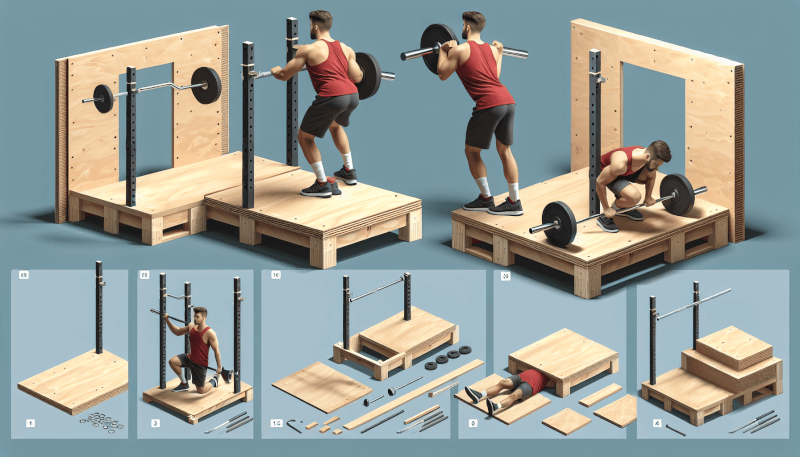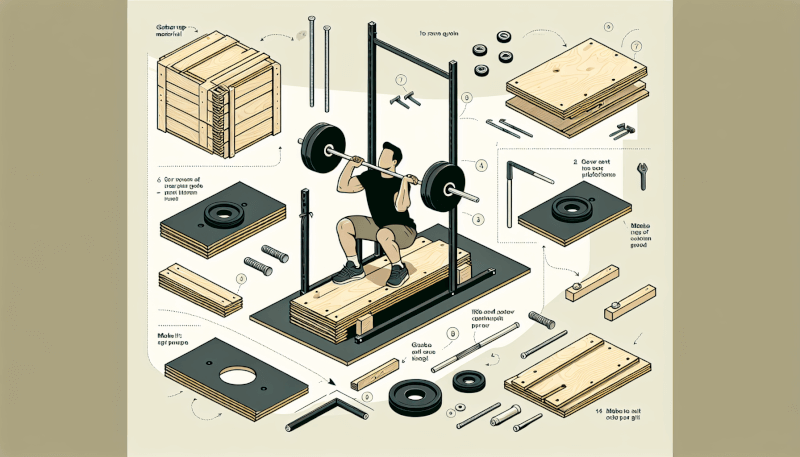Are you tired of paying expensive gym memberships and traveling long distances just to get in your daily workout? Look no further! In this comprehensive guide, you will discover the secrets to creating your very own DIY home gym weight lifting platform. Transform your garage or spare room into a personal fitness paradise, complete with a sturdy and durable platform that can withstand your toughest workouts. Say goodbye to crowded gyms and hello to ultimate convenience – all at the comfort of your own home. Get ready to take your lifting game to new heights with this easy-to-follow guide.

What is a DIY Home Gym Weight Lifting Platform?
Definition and Purpose
A DIY home gym weight lifting platform is a specially designed surface that provides a stable and durable area for performing weightlifting exercises. It is typically made up of a wooden frame with a thick layer of plywood on top, which creates a supportive and impact-absorbing surface for weights to be dropped on.
The primary purpose of a weight lifting platform is to protect the flooring underneath from damage caused by heavy weights. It also helps to reduce noise and vibrations, making it a great addition to a home gym setup. Additionally, a weight lifting platform provides a level and safe surface for performing various exercises, promoting proper form and reducing the risk of injury.
Benefits of Using a Weight Lifting Platform
Using a weight lifting platform in your home gym offers several benefits. Firstly, it provides a dedicated space for your weightlifting exercises, creating a defined area that separates your gym area from the rest of your home. This can help promote focus and motivation during workouts.
Secondly, a weight lifting platform significantly reduces the impact and stress on your flooring. Without a platform, repeatedly dropping heavy weights directly on the ground can cause cracks, dents, and other damage. By investing in a weight lifting platform, you can protect your flooring and avoid costly repairs.
Furthermore, weight lifting platforms help dampen noise and vibrations caused by dropping weights. This is especially important if you have neighbors or live in an apartment building, as it prevents disturbances and maintains a peaceful environment.
Lastly, a weight lifting platform provides a stable surface for your exercises. The firm and even base allow you to generate maximum power and stability during lifts, improving your overall performance and reducing the risk of injury.
Materials and Tools Required
Specifications for the Platform
Before you start building your DIY home gym weight lifting platform, it’s essential to determine the specifications that will best suit your needs. Here are some key considerations:
Size: Measure the available space in your home gym to determine the appropriate size for your platform. A standard platform is typically 8 feet by 8 feet, but you can adjust the dimensions to fit your space.
Thickness: The ideal thickness for the plywood top of your weight lifting platform is typically 3/4 inch. This thickness provides sufficient support and durability while dampening the impact of dropped weights.
Materials Needed
To build a DIY home gym weight lifting platform, you’ll need the following materials:
Plywood: Purchase a sufficient amount of 3/4 inch thick plywood, based on the size of your platform.
Two-by-fours: These will be used to build the wooden frame for the weight lifting platform.
Wood screws: Choose appropriately sized screws to secure the frame and plywood together.
Subfloor adhesive: This adhesive will ensure a strong bond between the plywood and frame, enhancing the stability of the weight lifting platform.
Tools Needed
To assemble your weight lifting platform, you will need the following tools:
Tape measure: Use a tape measure to accurately measure the dimensions of your platform and cut the materials accordingly.
Circular saw or table saw: These tools will be necessary to cut the plywood and wooden frame to the desired dimensions.
Drill: A drill will be needed to create pilot holes and drive screws during the assembly process.
Screwdriver: Use a screwdriver to tighten the wood screws securely.
Level: A level will help ensure that the weight lifting platform is perfectly flat.
Paint or sealant (optional): If desired, you can paint or seal the plywood to protect it from moisture and increase its longevity.

Step-by-Step Guide to Build a DIY Home Gym Weight Lifting Platform
Preparing the Area
Clear the designated area in your home gym, ensuring it is clean and free from debris. This will provide a suitable space for assembling the weight lifting platform.
Measure and mark the dimensions of your platform using a tape measure and painter’s tape. This will help you visualize the final layout and ensure accuracy during construction.
Building the Frame
Cut the two-by-fours to create the frame for your weight lifting platform. The dimensions should match the length and width of your platform, accounting for the thickness of the plywood.
Assemble the frame by securing the corners with wood screws. Ensure that the frame is sturdy and level using a level.
Attaching the Plywood
Apply subfloor adhesive to the top surface of the frame, ensuring even coverage.
Carefully lay the plywood on top of the frame, aligning it properly and pressing it down to ensure a strong bond.
Drive wood screws through the plywood into the frame along the edges, spacing them approximately every 6 to 8 inches. This will secure the plywood firmly to the frame.
Optional: If desired, paint or seal the plywood to protect it from moisture and increase its durability.
Adding Finishing Touches
Trim any excess plywood that extends beyond the frame using a circular saw or table saw. This will give your weight lifting platform a clean and finished appearance.
Sweep and clean the platform to remove any dust or debris.
Congratulations! You have successfully built your DIY home gym weight lifting platform.
Tips for Building and Using a DIY Home Gym Weight Lifting Platform
Safety Precautions
Always wear appropriate safety gear, such as gloves and safety glasses, when using power tools and handling heavy materials.
Ensure that the weight lifting platform is level and stable before using it to prevent accidents or injuries.
Choosing the Right Size
Consider the available space in your home gym and your specific workout needs when determining the size of your weight lifting platform. It should be large enough to accommodate your exercises comfortably without impeding your movements.
Adding Additional Features
Depending on your preferences, you can customize your weight lifting platform by adding rubber flooring mats or a layer of stall mats. These additional features can further dampen noise and vibrations while providing extra protection for your flooring.

Maintaining and Cleaning Your Weight Lifting Platform
Regular Cleaning
To keep your weight lifting platform in good condition, regularly sweep or vacuum the surface to remove dust and debris. You can also use a damp cloth or mop to wipe down the platform and remove any stains or spills.
Checking for Damage
Inspect your weight lifting platform periodically for any signs of damage, such as loose screws or cracks in the plywood. Tighten any loose screws and replace any damaged parts promptly to ensure the longevity of your platform.
Replacing Worn-out Parts
Over time, the plywood or wooden frame may become worn or damaged. If you notice any significant wear or damage, it is recommended to replace the affected parts to maintain the safety and performance of your weight lifting platform.
Alternatives to Building a DIY Home Gym Weight Lifting Platform
Purchasing a Pre-Made Platform
If building a DIY weight lifting platform is not feasible for you, there are pre-made platforms available for purchase. These platforms come in various sizes and are often made from high-quality materials, providing a convenient and efficient option for setting up your home gym.
Using Commercial Gym Facilities
If you don’t have the space or resources to set up a home gym, consider using commercial gym facilities. Most commercial gyms provide weight lifting platforms as part of their equipment, allowing you to perform your exercises in a dedicated and well-equipped space.

DIY Home Gym Weight Lifting Platform Vs. Commercial Options
Cost Comparison
Building a DIY home gym weight lifting platform generally offers significant cost savings compared to purchasing a pre-made platform or joining a commercial gym. By sourcing the materials and assembling the platform yourself, you can control the expenses and achieve a budget-friendly solution.
Customization Options
Building your own weight lifting platform allows for customization to fit your specific needs and preferences. You can choose the dimensions, materials, and additional features according to your workout routine and available space. Commercial options may offer some customization, but they are often limited to predefined specifications.
Durability and Longevity
When built properly and maintained regularly, a DIY weight lifting platform can be just as durable and long-lasting as commercial options. The quality of the materials used and proper construction techniques are crucial factors that contribute to the longevity of the platform.
FAQs about DIY Home Gym Weight Lifting Platforms
Can I use a weight lifting platform for other exercises?
Yes, a weight lifting platform can be used for various exercises, including deadlifts, squats, and Olympic lifts. Its stable and shock-absorbing surface provides an ideal environment for these exercises.
How much weight can a DIY weight lifting platform support?
When built following proper construction guidelines, a DIY weight lifting platform can support the same amount of weight as commercial platforms. However, it is essential to regularly inspect the platform for any signs of wear or damage and replace worn-out parts to maintain its strength.
Can I use different types of flooring for the platform?
While plywood is the most commonly used flooring material for weight lifting platforms, you can experiment with different materials according to your preferences and workout needs. Rubber flooring mats or stall mats can be placed on top of the plywood for added protection and noise reduction.
Can I disassemble and move the platform if needed?
Yes, you can disassemble and move a DIY weight lifting platform if required. Simply unscrew the plywood from the frame, dismantle the wooden frame, and carefully transport the components to the desired location. This flexibility allows you to adjust your home gym setup as needed.

Conclusion
A DIY home gym weight lifting platform is a valuable addition to any home gym setup. It provides a safe, durable, and noise-dampening surface for performing weightlifting exercises, protecting your flooring from damage and enhancing your performance. By following the steps outlined in this comprehensive guide, you can create your own weight lifting platform that suits your needs and budget. Whether you choose to build one yourself or opt for commercial options, a weight lifting platform is a worthwhile investment for anyone serious about strength training and fitness.


